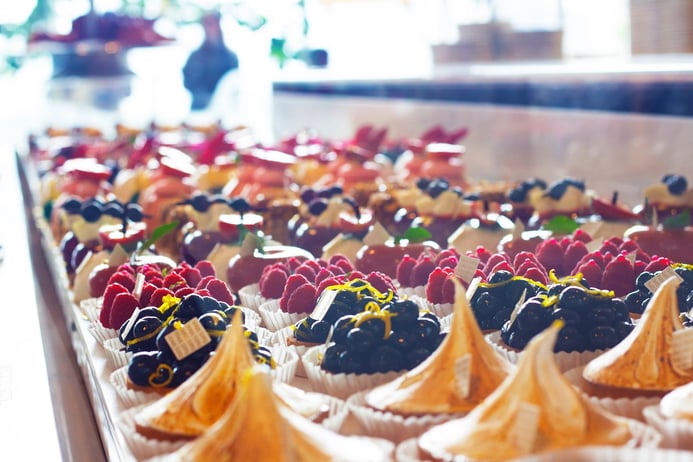Who doesn’t enjoy relaxing over a scrumptious dessert after a fine meal or even a casual lunch? However, many of us may not realize that many restaurants prefer their diners to forgo the grand finale. Why is that?
Well, gross profits earned on a dessert are not that tasty, the additional time that guests take to linger over a serving of chocolate or fruit tart may eat into overall profit margins, making the sweet serving a bit of a bitter reality to the bottom line of an eatery.
The proof is in the pudding
Food in general is tough to make money on because of the associated slim profit margins, therefore, restaurants historically relied on highly marked-up items like beer, wine and cocktails to bolster profitability.
When it comes to dessert, well made, delicious delights require authentic ingredients that tend to be expensive, such as real cream, berries out of season and high quality cocoa for example. Customers demand the finest desserts, yet will rarely pay a price that covers their true cost, let alone leave a few pennies on the table towards profits.
Thus, many restaurants price their desserts based on driving sales rather than selling at an appropriate price, resulting on break even or loss for the business.
A Michelin 3 Stars Restaurant experience is very much similar to a fashion show. One expects it to end with a Grand Finale: The Pastries. For this reason, this art contributes greatly to the image and reputation of an establishment if not to its profitability. describes Chef Philippe Gobet, Meilleur Ouvrier de France and renowned Pastry Chef.
An in-house luxury
Another reason desserts tend to be a drain on the bottom line is the expense of operating and maintaining an in-house bakery to create stellar confections.
Pastry chefs take years of specialized training to hone their skills, and the best chefs demand commensurate wages for those skills. Even for larger, well-established restaurants, the process of hiring pastry chefs, creating a dessert menu and virtually cordoning off a section of the kitchen just for dessert production can be difficult.
Adding to the challenge is predicting how many diners will order an after-dinner sweet. Almost all will order an entrée, but many will skip the added calories or cost of dessert.
The pastry world exploded in taste but also in technology. It now requires specialized material which are increasingly costly and demand management expertise. It therefore does not make sense for all eateries to invest in such expenses. continues Chef Philippe Gobet.
A little help from the outside
To avoid the additional costs of staff and kitchen space, some restaurants turn to outsourcing dessert production to local bakeries or specialized suppliers.
High-end restaurants are very marginal compared to the millions of restaurants out there. And if the former can afford to invest in specialized staff, obviously the mainstream eateries, whose priority is to streamline sales and not lose money, should investigate external suppliers and concentrate on the customization of their desserts. explains Chef Philippe Gobet.
This option can be an efficient method: eateries can order fresh or frozen desserts, have them delivered, and then serve them on demand while the chefs put their efforts into the main menu selections. Many bakeries can even supply confections that come ready to be branded, allowing the line cooks to add a unique touch or creative adornment to make them look as if they were made in-house.
In restaurants where outsourcing is not an option, morning shifts are scheduled to whip up delectable desserts to be stored in the cooler throughout the day. This led to a proliferation of nearly indestructible desserts such as pudding or frozen concoctions, which do not tend to feast the clientele.
The perfect timing
Time is quite literally money. Indeed, a fast turnover makes for restaurant profitability but also for happier clientele.
Managers want to turn over a table as quickly as possible to maximize the revenue generated. Ordering dessert slows down the turnover rates while not adding much to the total bill and creating additional lines of diners waiting to finally be seated.
By adding higher margin digestives or coffee drinks to their dessert order, restaurant profitability may be enhanced and by proposing a fast service, its reputation maintained.
Finally, the dessert dilemma is mainly a problem for busy mid-priced restaurants. High-end restaurants with slower traffic and strong reputation, benefit from more elastic prices and are less affected by tables turn over.
Pastries are a restaurant must. Of course the excellence of the “cuisines” as a whole is important but the avalanche of homemade pastries, served individually or on a trolley / buffet, play an important role in sublimating the dining experience. concludes Chef Philippe Gobet.
Desserts aren't going to disappear from restaurant menus. So if you’re going to stick around, make sure to add a coffee or digestives to your dessert or order one of the famous “Cafés Gourmands”. You will be participating in the profit of your favorite eatery and encouraging them to develop their Dessert offering.





